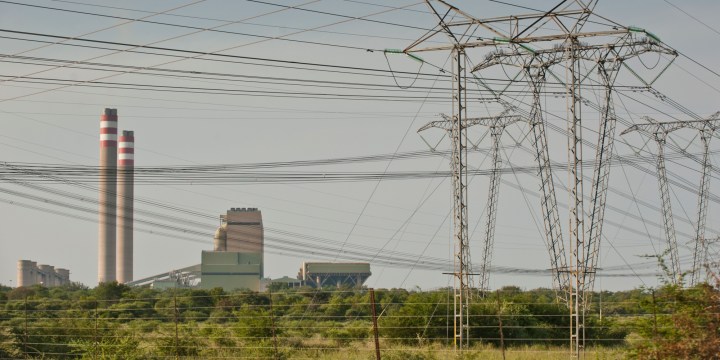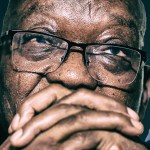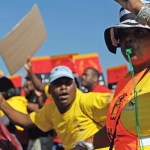OUR BURNING PLANET
Medupi’s R6.8bn New Development Bank injection and other BRICS climate crimes

Although the $480-million project loan from the New Development Bank for the completion of Medupi has been dubbed ‘clean technology’, it will up the carbon footprint of one of the world’s largest and most expensive coal-fired power plants. This would be more surprising if four of the BRICS nations, including South Africa, hadn’t been pivotal to a backroom climate deal at Copenhagen in 2009 that removed binding emission reduction targets for every country on Earth. So what else can we thank the BRICS bank for?
I. Undisclosed
“A resounding success.”
This, in a nutshell, was how Finance Minister Tito Mboweni viewed the fourth annual meeting of the New Development Bank (NDB), held in Cape Town from 31 March to 2 April 2019. The phrase was used in the first sentence of the press release sent out within minutes of the meeting’s wrap-up, with the excitement located primarily in the fact that three of the five new projects approved for funding by the NDB board were South African. As regards the largest of these projects, the press release stated this:
“Eskom: In line with its focus on supporting clean energy in South Africa, the NDB will provide a $480-million project loan to Eskom for (an) environmental protection project for (the) Medupi Thermal Power Plant.”
And so, at a cost overrun of 200%, with a history of tender fraud that involved the ANC’s investment arm Chancellor House and the lending collusion of the World Bank — not to mention the 32 million tons of carbon dioxide (C02) that would be spewed into the atmosphere every year, a figure that would place it on par with the national emission total of oil-soaked Angola — there was no longer any doubt: Medupi would be built and funded to completion.
But what did our finance ministry mean by “clean energy” and an “environmental protection project”? Had the devastation of Cyclone Idai, the strongest warning yet that African governments needed to face up to the realities of climate change, finally roused the policymakers in Pretoria? Was Medupi now headed for a long bath with real soap, a technological scrubbing that would drastically reduce its emissions and restore it to climate purity?
It appears not.
“The proposed project includes retrofitting Medupi with flue gas desulphurisation units to achieve compliance with the requirements of South Africa’s environmental legislations,” noted the NDB on its website, after insisting — in the same paragraph — that South Africa had “abundant coal resources” and a government that fostered “green growth”. These units, the bank stated, would reduce the sulphur dioxide (S02) emissions of the power plant from 3,500 milligrams per cubic metre to below 500 milligrams per cubic metre.
Which was great as far as SO2, a nasty-smelling toxin with the capacity to cause severe respiratory problems, was concerned. Like South Africa’s finance ministry, however, the NDB neglected to mention that SO2 was not considered a direct greenhouse gas by the United Nations Framework Convention on Climate Change. To dip briefly and necessarily into the science, here was what the Centre for Environmental Rights, Earthlife Africa and Groundwork had told South Africans about flue gas desulphurisation (FGD) in a report released in February 2019:
“Using wet FGD — a mixture of limestone (powder) and water — C02 emissions per unit of power sent out increase by 1-2%, depending on the sulphur content of the coal. Dry and semi-dry FGD processes require lime or hydrated lime because a greater reactivity is required, and the sorbent-to-S02 ratio is significantly higher compared to wet FGD. At temperatures below 900°C, no C02 is released and there is no increase in C02 emissions due to the FGD process itself. But both lime and hydrated lime are produced by the process of calcining (heating) limestone, which releases C02. Dry or semi-dry FGD processes using lime or hydrated lime as sorbents will result in an overall increase in C02 emissions, probably by 2%-3%, if the lifecycle of the process is considered.”
In other words, while the NDB’s $480-million (R6.8-billion) intervention would reduce the potential for acid rain and bring welcome relief to asthmatics in Medupi’s immediate vicinity, when it came to the existential threats posed by climate change — threats already reflected in the rising incidences of domestic violence in South Africa’s drought-affected communities, for instance, or the impossible choices between starvation and dying of disease in Beira, Mozambique — it would only make the problem worse.
As a reminder, as far as the burning of fossil fuels went, science had first pointed to the human role in the warming planet back in 1896, with papers already starting to appear in the late 1930s linking rising CO2 levels to the changing climate. But by early 2019, with wildfires in North America, droughts in Australia, tropical storms in Africa and floods in Europe delivering the chaos that had long been predicted, CO2 emissions from our dependence on fossil fuels were hitting record highs.
Which begged the question: Why was Finance Minister Mboweni, who was also serving as chairman of the board of governors of the NDB — a bank launched in 2015 by Brazil, Russia, India, China and South Africa (the BRICS bloc) to act as an alternative to the World Bank and the International Monetary Fund — framing this project as “clean energy”? Jim Yong Kim, after all, the World Bank’s former president, had exposed himself as a climate perjurer on the very same point in 2012, when on a visit to South Africa he’d spoken about Medupi in terms of “clean coal”.
The answer may have less to do with Mboweni himself, whose championing of the carbon tax has set him apart from all other members of the South African executive, than with the inner workings of contemporary geopolitics. As it turned out, this wasn’t the first time that members of the BRICS bloc had betrayed their kinship with the nations and institutions they were pretending to offset.
II. Unbound
“The key moment at Copenhagen was when President Barack Obama burst into a room where the leaders of Brazil, South Africa, India and China were meeting in private,” we read on page 65 of the climate classic Power in a Warming World, “and together the group of five nations set aside the existing negotiating texts entirely and drafted their own deal. The draft mentioned the goal of keeping global mean temperatures under a 2°C rise, but they avoided any binding emissions reduction targets to achieve that and any mention of the time when perilously rising emissions would peak and begin to fall.”
By this indisputable account, then, the date when BRICS was forever compromised by the G7 was 8 December 2009, at COP15 in Denmark. Before then, as per the Kyoto Protocol, there were binding national commitments based on set levels of emissions. Internationally acclaimed activist and author Andreas Malm, who has faced down riot squads and water cannons at dozens of climate protests over the years — the same man who coined the phrase “fossil capitalism” — had this to say about what changed at Copenhagen:
“The EU, the World Trade Organisation, the International Monetary Fund, the whole global architecture of neoliberal institutions is replete with mechanisms for punishing countries that fail to honour their obligations, but on this particular issue — averting cataclysmic breakdown of the biosphere as we know it — there shall be freedom.”
Leaving the ideology out of it (Malm, to be sure, is an avowed socialist), such facts speak for themselves. Nations can now decide what contributions they would like to make for meeting global emissions targets, and they can submit their own timelines for doing so — a voluntary programme, Malm pointed out, that’s akin to saying “if bankers can choose whether to pay taxes or not, more of them will”.
The upshot, according to the authors of Power in a Warming World, is that the arbitrary and free-floating pledges of the world’s governments have condemned us all to a temperature rise of between 3.5°C and 4.5°C, which happens to be roughly what the journal Nature is predicting by 2100 if emissions continue on their current track. For South Africans, who will continue to experience warming at twice the global average, such temperatures will mean nothing short of a climate holocaust.
So why did the four BRICS members, who Barack Obama had astutely identified as the pivotal players in Copenhagen, turn their backs on the island states and smaller developing nations that were least to blame but most vulnerable to the portended catastrophes? Power in a Warming World provides the cross-referenced and footnoted answer. The authors refer to these four countries as the “emerging emissions powers” who saw “more value in working together than in being tethered to their former peers”.
By joining forces, they note, these “growing giants” could more easily resist pressures from both industrialised nations and the LDCs (least developed countries) to reduce their emissions, thereby ensuring that their carbon-intensive development agendas could proceed unimpeded.
What’s more, irrespective of the countless innocents that would be lost down the line, the four giants were now playing a version of realpolitik where the truth could be hidden in plain sight. In October 2015, in the lead-up to COP21 in Paris, a South African career diplomat by the name of Nozipho Joyce Mxakato-Diseko found herself in the role of lead negotiator for a grouping of more than 130 developing nations and China.
“It is just like apartheid,” she said into the microphone, after discovering that the draft text of her “climate rescue pact” had been subjected to an unsolicited edit. “We find ourselves in a position where in essence (the poor) are disenfranchised.”
Today, instead of having been cast out into the wilderness for such honesty, Mxakato-Diseko is still South Africa’s ambassador-at-large for climate change.
As for Russia, the only BRICS nation that wasn’t in the room in Copenhagen that day, one needed to look no further than the two loans the NDB had granted Moscow since its inception. At the University of Johannesburg on the afternoon of 3 April 2019, Ilya Matveev of the Russian Presidential Academy of National Economy and Public Administration in St Petersburg gave us an insight into the larger of these loans — the $300-million for a petrochemical plant in the Tyumen region, operated by Sibur, and classified as “sustainable infrastructure”.
“It’s not clear what’s sustainable about it,” Matveev told the gathered academics, who had come for the Gauteng leg of the national roadshow that had been set up to coincide with the NDB’s annual meeting in Cape Town.
“First of all, it’s in the fossil fuel industry. Secondly, the point of this plant is to produce plastics. So plastics may have different applications, but at least some of those produced by this plant will be single-use. The next interesting thing about this project is the company that operates this petrochemical plant.”
Sibur, Matveev explained, is a prime example of “crony capitalism” in Russia, a company that’s “one of the most tightly controlled by the Putin regime”. Its largest shareholder at 48.5%, Leonid Mikhelson, is Russia’s wealthiest individual, whose personal fortune of $23.6-billion is linked in the main to his stake in the natural gas behemoth Novatek. Mikhelson’s partner in both Novatek and Sibur is Gennady Timchenko — known to be a close friend of President Vladimir Putin — who owns 17% of the petrochemicals conglomerate.
Aside from management at 10%, the other major shareholders in Sibur, at 10% each, are China’s Sinopec and Silk Road Fund, the latter of which is intimately connected to the Belt and Road Initiative, the world’s largest development project — with climate and environmental consequences for Africa that Daily Maverick has reported on at length.
Then there’s Kiril Shamalov, Putin’s former son-in-law, who became the youngest billionaire in Russia when, in a non-transparent deal, he acquired a 20% stake in Sibur soon after his marriage to Putin’s eldest daughter. According to Matveev, as the son of Nikolai Shamalov — another of Putin’s close friends — he got to keep 3.9% of the company after the divorce.
As per the NDB’s own documentation, the approval date for the $300-million loan to Sibur was 18 September 2018, when all of this had long been a matter of public record. Matveev’s assertion that the petrochemical plant would be the largest in Russia was backed up by the NDB’s statement that, once fully operational, “the complex would cover Russia’s demand for most polyolefins and increase export capacity of Russia’s petrochemicals sector”.
Like the $480-million loan to Eskom in South Africa, the NDB had framed its advance to Sibur in terms of “environmental protection” — mainly because a portion of the funds, not stipulated, had been set aside for “wastewater treatment facilities”. But while the loan had been “classified as category A in accordance with the NDB’s Environment and Social Framework (ESF),” nowhere in the document could one find the phrase “single-use plastics” or “carbon footprint”.
III. Unrepentant
In his epoch-defining The Uninhabitable Earth: Life After Warming, which the New York Times recently compared to Rachel Carson’s Silent Spring — a book that singlehandedly launched the environmental movement in the early 1960s — journalist David Wallace-Wells made the following observation about Russia and climate change:
“Putin, the commandant of a petro-state that also happens to be, given its geography, one of the few nations on Earth likely to benefit from continued warming, sees basically no benefit to constraining carbon emissions or greening the economy — Russia’s or the world’s.”
In this light, the allegation of “tokenism,” by which Matveev characterised the other loan granted Russia by the NDB — $100-million for a “renewable energy” hydropower plant in the Karelia region — seemed to carry some weight.
Can the same be said of the $560-million that the NDB has earmarked in the past two weeks for the renewables sector in South Africa?
The sum — comprised of “up to” $300-million to the Development Bank of South Africa for investment in wind, solar and biomass projects; $180-million to Eskom for the integration of 670 megawatts of renewable power into the national grid; and $80-million to the Industrial Development Corporation for on-lending to renewable energy sub-projects — is significant. If South Africa wasn’t the largest greenhouse gas emitter in Africa, if our “abundant coal resources” weren’t openly celebrated by the NDB, if the number wasn’t dwarfed by what the local taxpayer was pouring into the subsidisation of fossil fuels, this R7.9-billion in kick-start funding to the renewables sector might have looked a lot more “clean”.
Lest we forget, as recently as mid-March 2019, we heard from Eskom’s chairperson Jabu Mabuza that the power utility was considering abandoning Medupi and its sister plant Kusile. The R300-billion cost of construction for the plants, double their original budgets, had rendered them the most expensive coal-fired power projects in the world, and Eskom — as per Mabuza — had been conducting an exercise to look into the effect on the utility’s financial situation (that is, its debt of R419-billion) of “not completing” construction.
But again, on the afternoon of 3 April 2019, less than 24 hours after the finance ministry had declared the NDB annual meeting a “resounding success,” Mabuza announced that Medupi and Kusile were back on. Supported by Public Enterprises Minister Pravin Gordhan, the presentation listed Eskom’s objectives, the first of which was “to be transparent and frank with South Africans”.
As this was happening in a conference room at the Lethabo Power Station in the rural Free State, Matveev was finishing up his address at the University of Johannesburg. He was followed on stage by Ranjinta Mohanty, an author from Delhi, and Brian Mier, a correspondent for TeleSUR in Sao Paulo, who gave us their take on the human rights abuses and environmental crimes that had been perpetrated by Prime Minister Narendra Modi of India and President Jair Bolsanaro of Brazil.
“How does this relate to the BRICS?” Mier asked, after showing us a video of the groundswell of support for former president Luiz Lula da Silva, who had been imprisoned by the Bolsanaro regime for corruption in early 2018 (a similar video would air on Al Jazeera on 8 April 2019, to commemorate Lula’s first year in prison).
“Lula was leading in all polls in the presidential race last year (2018), promising to re-nationalise petroleum and to reverse the austerity measures that were enacted after the coup. He was illegally taken out the race.”
Mier’s argument, which leaned on the fact that the United Nations Human Rights Committee had ruled that Lula should not be prevented from running in the 2018 Brazilian elections — given that he had been arrested before his appeals process had been completed — placed the carbon economy front and centre. If a BRICS leader wasn’t amenable to the burning of fossil fuels for private gain, the reasoning went, such a leader couldn’t serve.
Was it really that simple? The evidence was hard to refute. Xi, Modi, Putin, Bolsanaro, Ramaphosa — all were presiding over countries that were among the top 14 emitters in the world according to the Global Carbon Atlas, with China, India and Russia occupying three of the top five places, and Brazil and South Africa leading their respective continents.
“When the NDB started dishing out money, they forgot about their own cut-and-paste social and environmental frameworks,” said Earthlife Africa’s Makoma Lekalakala, winner of the 2018 Goldman Prize for her role in scuppering the South African government’s secret $76-billion nuclear deal with Russia, who got up to speak after Mier.
“The projects they are funding are climate-destroying projects.” DM

















 Become an Insider
Become an Insider